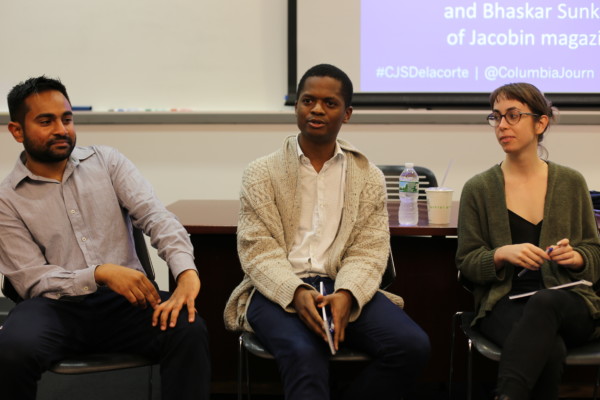Sign up for The Media Today, CJR’s daily newsletter.
Three top editors at the fast-growing leftist political magazine Jacobin said at a Delacorte lecture Monday they’re content to focus on print and a niche audience instead of chasing the digital-media staples of video and scale.
Editor and Publisher Bhaskar Sunkara, Creative Director Remeike Forbes, and Assistant Editor Elizabeth Mahony on October 23 joined Columbia Journalism School George Delacorte Professor Keith Gessen for a conversation about socialism, their publication’s design, and building a strong subscription base.
The quarterly print magazine promises “socialist perspectives on politics, economics, and culture.” It launched in 2010 but has grown quickly. Its paid circulation has risen to more than 36,000—up from 19,263 in June of last year—and its website now draws more than a million views each month.
“I think the longer that Jacobin has existed, the more people understand what our style and our content is, and the easier it has been for us to attract writers who are able to do that fairly well,” says Mahony, who joined in 2015. “I do think it’s grown into itself.”
Jacobin has the equivalent of 12 full-time paid staff members, three of whom are designers. Forbes, who has an MFA from the Rhode Island School of Design, says the magazine invests in design because the majority of its content is available for free, and design is integral to sales of the print edition. Sunkara estimates 80 percent of the company’s revenues are from print subscriptions. “You have to do print well,” says Forbes. “You have to think about the product itself that’s also appealing to people and they’re happy to have on their shelf.”
ICYMI: ‘What’s bad for the nation is good for The Nation’
Articles found on Jacobin’s website and its print pages include pieces on wealth inequality, the power of mass protest, and the economic reasons behind Puerto Rico’s crisis after Hurricane Maria. The anti-capitalist tone encapsulates topics as varied as environmentalism (the theme of issue No. 26), the NBA, and healthcare. “We joke sometimes that if a bot would spit out a Jacobin article it would be, ‘It’s not Culture, it’s Economics!’” Mahony says. “Which is a really didactic way of saying we think there are really material structural causes for what we’re seeing in front of our faces right now.”
While the magazine often emphasizes the importance of unions, it also highlights when they’ve failed to act on behalf of their members. Following widespread coverage of sexual harassment and sexual assault in the post-Harvey Weinstein era, Assistant Editor Alex Press reflected on her personal experiences to argue why collective action can help make workplaces safer, but Morgan Spector, in a separate piece, pointed out the failures of Screen Actor’s Guild to properly help its members.
“I’ve seen it happen in real life where a union does stop sexual harassment and one of the primary issues with sexual harassment is due to lax management,” Mahony says. “I’ve seen it happen many times where unions held bosses accountable.”
Sunkara had advice for people thinking about creating their own magazine: “Start with how you’re going to make money, not all the things you’re going to do,” he says. “The smarter people start with less ambitious short-term goals, but if [the publication] finds its market, readership, and support, it could expand.”
“The first couple of years things always go wrong, so a cushion is really important,” Sunkara says. “There’s a million other products you could sell and would be more fun to sell and you’d make more money—that’s where ideology comes in. The actual mechanics of the thing is the same is selling knives.”
ICYMI: An unlikely big player in digital media: unions
Has America ever needed a media defender more than now? Help us by joining CJR today.



